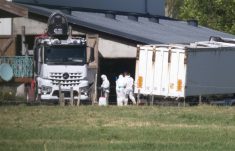Warning they “cannot be sustained in the long term” if they continue without federal backing, Ontario has pledged to rework, and to limit its contribution to, its Risk Management Programs (RMPs) for farmers.
Releasing its 2012 budget Tuesday, the provincial government said it will “continue to encourage” the federal government to cost-share Ontario’s RMPs, but in the meantime will limit the province’s support, net of farmer-paid premiums, at its 2011 budget level of $100 million.
RMP is a demand-driven program, funded in part by producer premiums, with total payouts that can fluctuate from year to year depending on commodity prices. The provincial government describes the RMPs as “a source of financial risk to the province, as payments can be unpredictable.”
Read Also

U.S. livestock: Cattle fall sharply as Trump says he’s working to lower beef costs
Chicago cattle futures fell sharply on Friday after U.S. President Donald Trump said his administration was working to lower the…
The RMP, which was expanded last year from a pilot program to a provincewide risk management offering for non-supply-managed crop and livestock producers, was developed outside of the five-year federal/provincial Growing Forward ag policy funding framework.
The province said Tuesday it “will work with farmers to redesign these programs to focus on supporting productivity, while capping the overall program at a sustainable level to manage taxpayers’ exposure and leverage federal dollars.”
As Ottawa and the provinces negotiate a follow-up framework to Growing Forward, which expires at the end of the 2012 budget year, Ontario plans to ask the federal government to “come to the table with its fair share of funding to support agrifood in Ontario.”
That would involve the federal government covering 60 per cent of RMP funding to the province’s 40 per cent, as per their levels of support for Growing Forward programming.
“Right choices”
Overall, Finance Minister Dwight Duncan’s 2012 budget proposes to cut costs by $17.7 billion over the next three years and boost revenues by $4.4 billion “without raising taxes.”
“We are making the right choices to ensure that Ontario families are receiving the best possible services and the best value for tax dollars,” Duncan said Tuesday.
Other line items in Tuesday’s budget include the previously-announced end to the Slots for Racetracks program, a funding arrangement with the province’s horseracing industry, which the province said will “allow the industry to respond competitively to market demands for its racing product.”
The province said it will continue to support horseracing through a reduction to the provincial pari-mutuel tax, a move it said will leave wagering revenues with the industry for “programming support.”
Farms and other larger-scale users of electricity can also expect increased electricity bills coming out of this budget.
Legislation is in the works to impose a cap of 3,000 kilowatt-hours per user per month on the remainder of the five-year Ontario Clean Energy Benefit (OCEB) the province launched at the start of 2011.
Electricity users over the cap would no longer receive the 10 per cent OCEB benefit, although the province noted other conservation programs are in place to help farms and businesses “in their transition away from the OCEB.”

















